Army Vietnam War Hobart, IN Flight date: 08/23/23
By Al Rodriguez, Honor Flight Chicago Veteran Interview Volunteer
James Sawyer called himself a reluctant soldier but he said there was never a question in his mind that he wouldn’t report to the induction center when he was drafted in 1970. Listening to him about his time in the Army, he did everything they asked, including a tour in Vietnam. I would think the Army could use more reluctant soldiers like him.
James was born in Gary, Indiana. His father was a WWII Navy veteran who served in the Atlantic and African Theater. He came from a family of three boys. As a youth living in the Miller neighborhood, he spent much of his time exploring the surrounding woods and of course the Lake Michigan beach. As a Boy Scout he loved being outside and living in a tent. He thinks that helped him with ‘camping out’ in Vietnam. He graduated from Andrean High School in 1967. James attended Indiana University Northwest in 1968 but switched to a business school in Chicago. Not happy with the school environment, he dropped out and went to work at Bethlehem Steel. Losing his student deferment, he was drafted in June of 1970.
After his induction he was sent to Fort Polk, Louisiana for his basic training. He remembers the heat and humidity and the old wooden WWII barracks. He said every bunk had a window over it, he guesses in case it caught fire they would be able to jump out the window. He was on the second floor so he didn’t know how well he would fare. After basic training he stayed at Fort Polk for Army Infantry Training and because of his testing they thought he had leadership qualities, so they had him continue with the Leadership Preparatory Course. In the LPC he was selected as a squad leader. After five months he finished his training and was assigned to duty in Vietnam as an infantry man.
After a 30 day leave to visit his family, he arrived in Chu Lai Vietnam November of 1970 assigned to the 2nd Platoon, B Company, 1st Battalion, 6th Infantry, 198th Light Infantry Brigade. James said things were strange in his year of combat. This was towards the end of the war and other battalions were being sent back to the U.S. He felt that the 198th Infantry was there for guard duty and keeping the American fire bases safe. The Vietnamization of the war, ARVN, South Vietnamese forces were responsible for more of the ground war being fought with the American forces in a supportive role. But that didn’t mean that the 198th wasn’t still conducting search and destroy missions, with local and long range patrols looking for enemy combatants. The long range patrols lasted between 12 and 18 days each. They would walk or be transported into an area. Their food was supplied by helicopter and water needs from local rivers or ponds. Dysentery was common. James came down with a mild case. He said that they never dug foxholes because of ground critters and the rain. They had hammocks and used their rain ponchos as a tarp to keep off the rain. James got a nickname in Vietnam on a patrol. He broke his glasses and the guys taped them up on the sides and the middle using duct tape so he could only see out of vertical slits. Someone yelled out that he looked like a Hawkeye and the nickname stuck.
B Company was ordered to help the ARVN to protect the village of An Tin. They were there for several weeks and on New Year’s Eve the VC launched an attack on the village. The 2nd Platoon was stationed on a hill overlooking the village. He said that from his vantage point he could see the ARVN firing into a wooded area. Suddenly he said the green bullet tracers started flying over his head and he heard a crack, the sound of a bullet passing near his ear. They returned fire and his platoon was credited with killing three VC. James received his Combat Infantry Badge after this action.
B Company was also involved in two other assaults. Typewriter Hill was so named because the CIA bugged a typewriter and it was tracked to the foothills of Quang Ngai. They were convoyed and then night marched near the hill with James and the Company commander as point men. With two hours sleep, he was awakened and going in the first wave. He said he felt like he had a rock in his stomach. Fourteen men walked towards the hill, knee deep in an abandoned rice paddy. They found a network of tunnels and surrounded the hill. By evening everything was calm. He was telling one of his platoon members about what a beautiful night it was when mortars and gunfire broke out. They returned fire but as quickly as the firefight started it ended. He said they waited for two days for the ARVN, CIA and tunnel dogs to arrive. They found the tunnels abandoned.
B Company was also order to Hill 814 near the Laotian border. They were transported by helicopters. 2nd Platoon was first in the landing zone and they were tasked to set claymore land mines on the trails. Orders changed and they moved to another area. The 1st Platoon were first to go up the hill and the point men came under fire, later known to be an NVA battalion strength force. Both point men were injured along with the medic who went to their aide. Two gunships were sent in to assist with little effect. The assault was stalled. Artillery fire was used to saturate the area. B Company was ordered to go to the other side of the hill which took them three days to reach. When the battle ended they found eighteen NVA dead and some documentation.
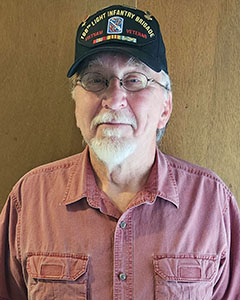
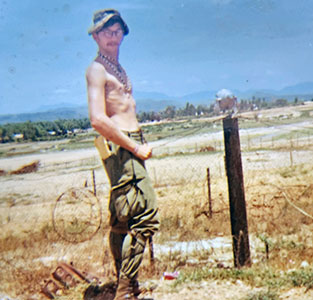
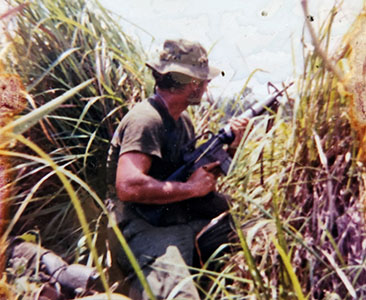
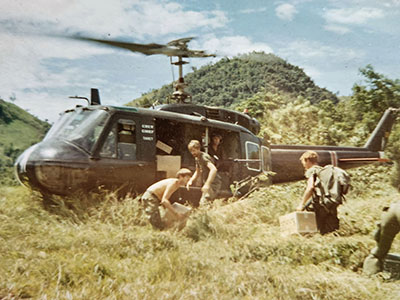
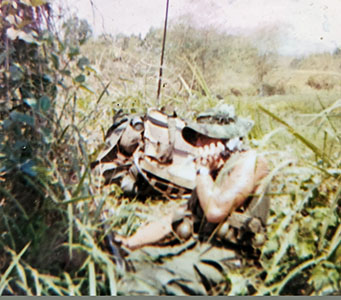
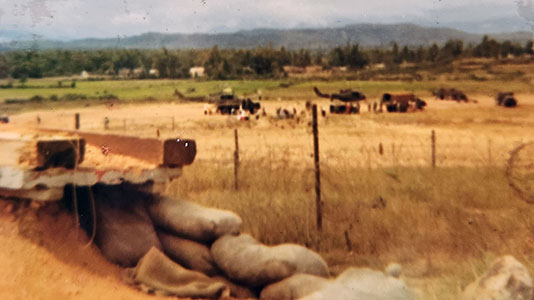
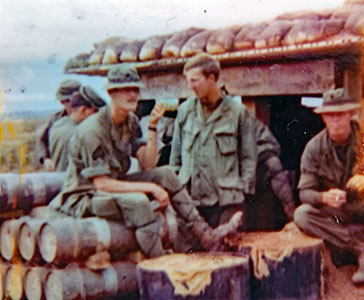
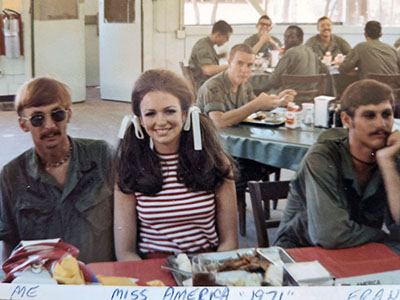
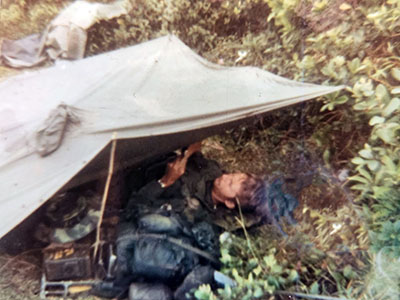
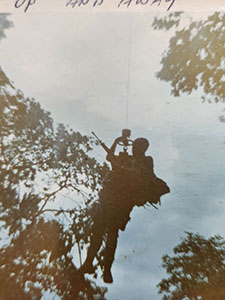
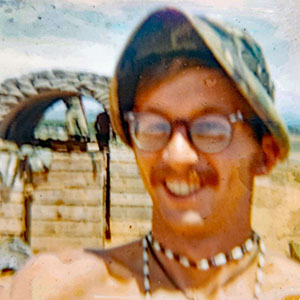
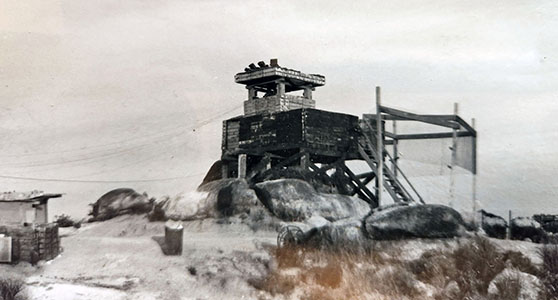
During Operation Lam Son 719, B Company was ordered for perimeter duty at Fire Base Dottie, about 10 kilometers south of Chu Lai. The ARVN manning the fire base who were actively supporting Lam Son 719 had not returned. On another long range patrol James and his sergeant set a quick ambush on five VC’s approaching their perimeter. They put their weapons on automatic and fired. Before they were able to reload, their Lieutenant coming up behind them was shot shattering his ankle. With bullets flying around them James and a medic helped the lieutenant get to a helicopter for evacuation.
Because his platoon was depleted, when they arrived at Chu Lai they were ordered to be security for a four man sniper team. The snipers would find a position in a tree; the platoon would secure the perimeter from the enemy. 2nd Platoon started with thirty-five men and was down to seven men due to illness, being wounded or rotating back to the states with no replacements. In October they were sent to Fire Base Bayonet just outside of Chu Lai for perimeter duty. Typhoon Hester came through their area. James said the wind blew the rain sideways and it felt like rocks hitting him. His bunker was three tiered and as the water from the typhoon filled the bottom tier, they would move up to the next tier. Even though they prepared for it, he said the typhoon caused more damage than the enemy ever did, aircraft toppled, buildings damaged and equipment strewn everywhere. Thirty-six people including three Americans died during the typhoon.
In November the 1st Battalion 6th Infantry began the process of packing up its equipment to permanently leave Vietnam. His last duty was to help clean 600 M16s to send back to the U.S. James flew out of Da Nang to Seattle and from there to Chicago on a 30-day leave. From Chicago he flew to Fort Hood, Texas to finish his time in the Army. He processed out on January 24th, a day before his birthday and he said that was the best birthday gift he could have received. He flew into O’Hare Airport at 6AM in uniform but there were no protestors around. His brother took him home and his mom had a welcome home banner at the house. He took a little time off and in April went back to work at Bethlehem Steel.
Going to Vietnam had one perk for James: during a USO show he got to meet and eat lunch with Phyllis George, Miss America 1971.
James had a girlfriend before he left for Vietnam and they wrote letters to each other while he was away. When he came home he felt they had nothing in common and he broke it off. A friend of his introduced him to his future wife, Mary. In 1977 after dating for five years their mothers decided they should get married and they complied. In 1979 they had a son and now have a grandson. As a family their hobby is to camp and fish.
James loves learning about the Civil War. He had a Great-Great Uncle that served in the 48th Kentucky that fought for the Union. In the 1990’s he joined the 4th Indiana Volunteers as an artilleryman shooting a 3” canon. He also joined a muzzleloader’s club; he said it is his favorite rifle to shoot. He’s a proud member of Vietnam Veterans of America, a national veteran’s organization serving the needs of all veterans throughout the nation.
Of his time in Vietnam, from his view riding on the helicopters he saw desolate areas stripped of trees and vegetation that he thought looked like the moon. He feels fortunate that he never got wounded, even though for four months he was a radioman, a hazardous job in a fire fight. He survived a powerful typhoon. His time in Vietnam wasn’t illness free, he got dysentery, dengue fever and a pinched nerve in his hip. He says the pinch nerve flares up once in a while. He also received a Bronze Star and doesn’t know why, seeing it on his DD-214 separation papers when he finished his active duty in the Army.
James is looking forward to his day in D.C. One of his to do’s on his bucket list is to see the Vietnam Wall and pay respects to all the names on it but especially to a childhood friend who was killed in 1968.
Thank you Hawkeye and enjoy your day!


